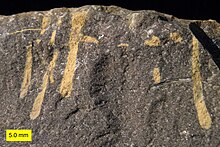| Trypanites | |
|---|---|
| Trace fossil classification | |
| Ichnofamily: | †Trypanitidae |
| Ichnogenus: | †Trypanites Mägdefrau, 1932 |
| Type ichnospecies | |
| Trypanites weisei Mägdefrau, 1932
| |
| Ichnospecies[1] | |
| |
| Synonyms[1] | |
| |



Trypanites is a narrow, cylindrical, unbranched boring which is one of the most common trace fossils in hard substrates such as rocks, carbonate hardgrounds and shells.[2] It appears first in the Lower Cambrian,[3] was very prominent in the Ordovician Bioerosion Revolution,[4] and is still commonly formed today. Trypanites is almost always found in calcareous substrates, most likely because the excavating organism used an acid or other chemical agent to dissolve the calcium carbonate.[5] Trypanites is common in the Ordovician and Silurian hardgrounds of Baltica.[6]
- ^ a b Wisshak, M.; Knaust, D.; Bertling, M. (2019). "Bioerosion ichnotaxa: review and annotated list". Facies. 65 (2): 24. doi:10.1007/s10347-019-0561-8.
- ^ Bromley, R.G. (1972). "On some ichnotaxa in hard substrates, with a redefinition of Trypanites Mägdefrau". Paläontologische Zeitschrift. 46 (1–2): 93–98. doi:10.1007/bf02989555. S2CID 84389155.
- ^ James, N.P., Kobluk, D.R., Pemberton, S.G. (1977). "The oldest macroborers: Lower Cambrian of Labrador". Science. 197 (4307): 980–983. Bibcode:1977Sci...197..980J. doi:10.1126/science.197.4307.980-a. PMID 17784131. S2CID 10479154.
{{cite journal}}: CS1 maint: multiple names: authors list (link) - ^ Wilson, M.A., Palmer, T.J. (2006). "Patterns and processes in the Ordovician Bioerosion Revolution". Ichnos. 13 (3): 109–112. doi:10.1080/10420940600850505. S2CID 128831144.
{{cite journal}}: CS1 maint: multiple names: authors list (link) - ^ Taylor, P.D., Wilson. M.A. (2003). "Palaeoecology and evolution of marine hard substrate communities". Earth-Science Reviews. 62 (1–2): 1–103. Bibcode:2003ESRv...62....1T. doi:10.1016/S0012-8252(02)00131-9.
{{cite journal}}: CS1 maint: multiple names: authors list (link) - ^ Vinn, O.; Wilson, M.A.; Toom, U. (2015). "Bioerosion of Inorganic Hard Substrates in the Ordovician of Estonia (Baltica)". PLOS ONE. 10 (7): e0134279. Bibcode:2015PLoSO..1034279V. doi:10.1371/journal.pone.0134279. PMC 4517899. PMID 26218582.